Seolleongtang is the ultimate hearty and comforting beef bone soup for Koreans. You need to invest some time into making this wonderful dish but definitely worth the time because it will make you feel so good and happy – all the way deep down in your bones. 😉
What is Seolleongtang?
Seolleontang 설렁탕 is a very popular everyday Korean beef bone soup dish with a milky creamy rich broth that’s made from boiling different beef bones (sometimes including even the head and tail but usually leg bones like shin, feet and knuckles) for hours – 10 hrs or so?
The broth is usually served with thin noodles, thinly sliced beef brisket or other cuts in a hot clay pot (ttukbaegi) or a large stainless steel bowl if you got it at a restaurant. At the table after it’s served, you garnish the soup with tons of chopped green onions or Korean leek (daepa) then season to taste with Korean sea salt and pepper.
Rice is traditionally added to the soup before serving but it’s served separately these days so people can control how much rice they eat.
History of Seolleongtang (Korean beef bone Soup)
There are a couple of different stories of how the name Seolleontang came to be. One story says that during the Joseon Dynasty, Kings participated in an annual offering ceremony to gods event in spring at planting time – to ask for gods blessings on that year’s crop. And the altar where this ceremony was performed was called Seon neong dahn 선농단 先農壇. FYI, Seon-neong 선농 together means basically ‘first farming’ and Dahn 단 means the altar.
And at the end of the ceremony, the King personally served the people with this very rich creamy beef bone broth soup that was cooked for days in preparation for the event. So the theory suggests that perhaps a combination of Seonneong + Tang (which means soup) became eventually Seolleongtang.
The other story was that the great King Sejong participated in the Seon neong ceremony and one year the weather was so windy and bad that the local people butchered a cow and made soup with the bones and meat to serve King Sejong.
Whatever the story – this soup has been a ‘soup of the people’ since my childhood and is just as popular today.
Best beef bones to use for Seolleongtang (Korean Bone Soup)
A variety of bones in your broth works best as each part adds a different flavor and amount of gelatin to your soup. Below, I have – knuckle bones (leg joints), shin bones with ligaments, marrow bones with meat attached.




The bones in the tray above weighed about 4.5 lbs. This was great because the bones were cut across into thinner cuts which maximizes the exposure of the marrow part of the bones.
Where can I buy beef bones for seolleontang?
Big Korean grocery stores will have these soup bones either in the freezer or in the refrigerator. You may also want to ask a local butcher if you can get these bones.
Alos, you can easily find and buy them online – just search for ‘beef bones for broth’ and you will find a few options!
Why Isn’t My Seolleontang Milky White and Opaque?
If you think you can just simply end up with a milky white creamy Seolleontang by boiling bones forever, you are mistaken. There are a few things that you need to pay attention to – otherwise, you can be boiling it for days and you will still not have a thick milky white broth.
tips for making your Seolleontang Milky White –
- BOILING HARD for at least 2 hrs or so – at the beginning of the broth making process, it’s important to let it boil vigorously so that the bones are shaken and stirred around enough to thicken the broth. This is probably the most common mistake people will make when trying to make Seolleongtang.
- DON’T ADD TOO MUCH WATER UNTIL IT TURNS WHITE – when you boil the bones for the first couple hours, it’s important that you keep the water just enough to cover the bones. That’s why I add 4 cups of water at a time, twice during the first hard boil step. If you add all the water at once from the start, the broth will not turn opaque white. The overall, bones to water ratio is important.
- I ALREADY ADDED TOO MUCH WATER, CAN I FIX IT NOW? – if you feel that you added too much water, too soon and the broth is not turning opaque after 3 hr or more of boiling, try taking some water out and leave just enough water to cover the bones. Boil for 2 hrs or more until it turns milky and then you can add more water and simmer.
How to make Seolleontang (Beef Bone Broth Soup)
Equipment
10 qt stock pot or bigger for 4 lbs bones – this basic recipe will produce 10 bowls of soup. If you don’t have such a big pot, you can divide it into smaller pots.
Ingredients
- 4-5 lbs of Beef Bones (shank, marrow, knuckle all works but best if you use a combination)
- 4.5 gallons water (22 quarts)
- 2 lbs or more Brisket (for topping)
- 1 large Korean leek (Daepa) or 3-4 green onions, chopped
- Korean sea salt (cheonilyeom), Black Pepper
- OPTIONAL
- Korean Glass Noodles (Dangmyeon) – add as much as you’d like, 1/4 cup cooked noodles for each bowl is plenty
- Cooked rice to have with your soup to make it a full meal
Step-by-Step Instructions
PRE-COOK and DISCARD FIRST BATCH
- Soak beef bones in cold water for 30 min or so. Some of the blood should leech out to the water and will turn the water pink.
- In a stock pot, add bones and 4 qt of water or just enough water to cover the bones. Cover and bring to boil then let it boil for 15 min. You will see brownish foamy stuff bubbling on top.
- Turn off heat and discard the liquid and save the bones. Quickly rinse the bones under water to clean off any brownish, foamy impurities.
- Rinse the pot and put the rinsed bones back in the pot with 4 quarts water.
DEVELOPING MILKY BROTH
- Bring the pot with rinsed bones and water to a full rolling boil (cover the lid but leave a little bit open so it doesn’t overflow)
- Continue to boil (not simmer) for 30 min. Add 4 more cups of water.
- Keep boiling at medium or a little above medium heat for 1 hr and then add another 4 cups of water. (Water level should be just covering the bones so add more water if they are exposed)
- Boil for another 1 hr or so. The bones need to be boiling vigorously during this first part for the broth to develop into a cloudy and milky white color. Reduce heat once you have the milky white broth. Reducing heat too soon may make it hard for you to achieve a milky color.

SIMMER
- Once the broth is opaque and milky white, add about 8 quarts of water and lower heat to medium low and keep it at full simmer.
- Continue the full simmer for 3 hrs. Add another 7 quarts of water and full simmer for 4 1/2 hrs until the broth is overall completely opaque, milky and wonderful like the picture above. You can also watch my video to see how the color changes from clear broth to milky opaque white broth.
Video on How to make Seolleongtang
Watch this 5 min narrated video to see how you cook Seolleongtang with beef bones. It’s amazing how the broth goes from clear water to thick milky white broth in 10 hrs or so!
OPTIONAL ADDITIONS –
Add COOKED BEEF BRISKET or FLANK
The bone broth is wonderful as is but traditionally, we cook some beef brisket and add to the soup.


TWO WAYS to COOK BRISKET
- In another pot (3-4qt or bigger) and add 1-2 lb Brisket or Flank Steak, 10 cups water, 1/2 onion, 1 green onion and a piece of radish if you have some and bring to boil then simmer for about an hour or until a fork goes in easily. For a more detailed and exact recipe, you can follow my Gogiguk recipe.
- OR.. just add the brisket to the bone broth for an hour or so during the simmering phase and cook until tender. Fork should go in easily when fully cooked.
- Take the brisket out, let it cool for a bit and thinly cut against the grain and serve with the bowl of soup.
Sliced Flank with Beef Tendon and Bone Meat

How to Serve and Eat Seolleontang (Korean Beef Broth Soup)
Seolleongtang is always served with some chopped green onions or Korean daepa (leek), Korean sea salt, black pepper and optionally some spicy Dadaegi sauce to add some spicy kick to the soup. As you can see in my video, you can also add some boiled thin noodles to the soup.
And then for the table, serve a bowl of rice, some Kimchis for banchan!
How to eat Seolleongtang
SEASON and GARNISH – Seolleongtang is supposed to be served with no seasoning so that each person can season to their liking. Season the soup with a small spoonful of Korean sea salt (cheonilyeom) and black pepper. Then add a heaping spoonful of freshly chopped green onions (left in the pic below) or Daepa (Korean leek). Additionally, you can make some Dadaegi 다대기 (1 Tbsp soy sauce, 2 tsp Gochukaru (chili powder), 1/2 tsp rice vinegar, 1 tsp garlic) to add some spicy kick!



BEST KIMCHI to serve with Seolleongtang
Any Kimchi will go well with Seolleongtang but the classic pairing is radish Kimchi – either Kkakdugi or Seokbakji. Or you can also make some Geotjeori or Mak Kimchi if you like cabbage kimchi.


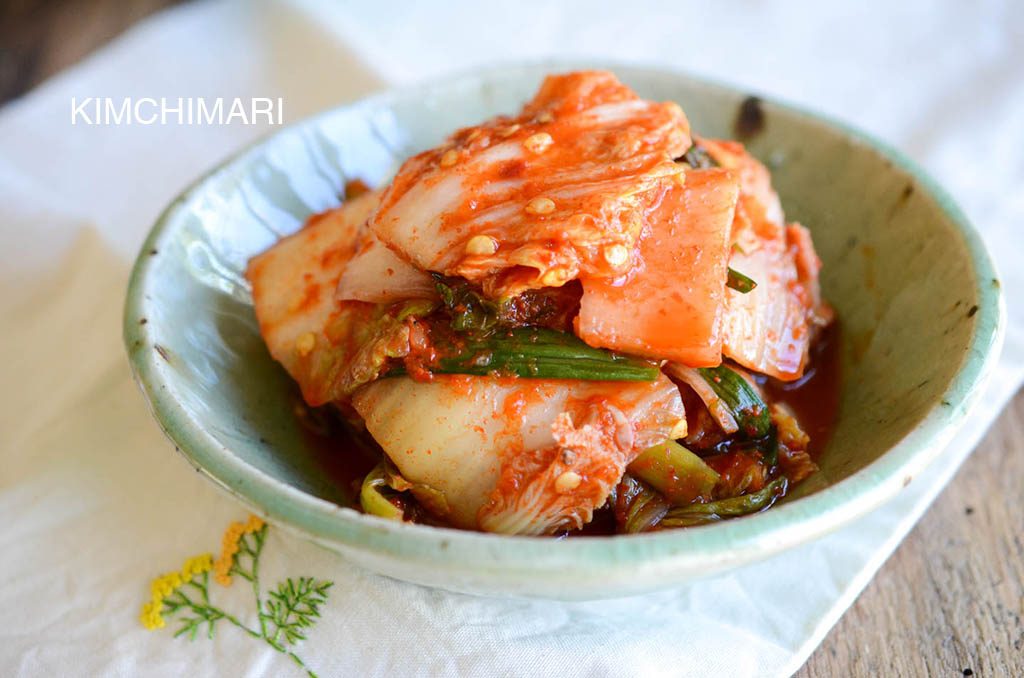
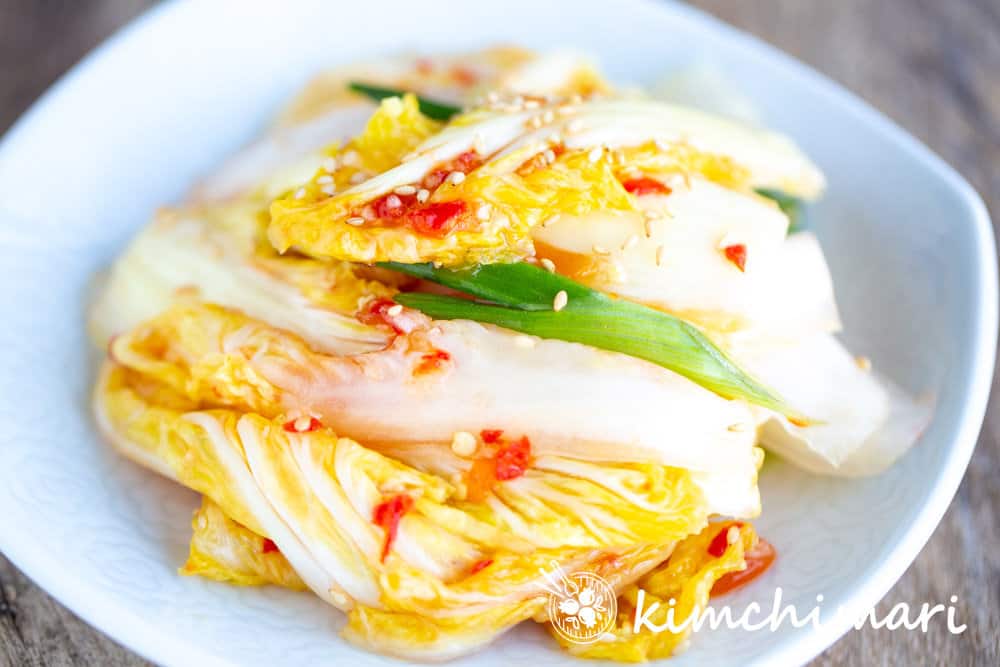
Seolleongtang (Korean Beef Bone Broth)
Ingredients
- 5 lbs beef bones marrow, femur, knuckle
- 5.5 gallons water or 22 quart
Garnish
- 2 green onions chopped
Cooked Beef Brisket Topping
- 1-2 lb beef brisket or Flank Steak
- 10 cups water
- 1/2 onion
- 1 green onion
- 1 piece radish
Optional Thin Noodles
- 1/2 packet thin noodles (somyeon 소면)
Instructions
- Soak beef bones in cold water for 30 min or so.
- In a stock pot, add bones and 4 qt of water. Cover with lid and bring to boil then let it boil for 15 min.
- Turn off heat and discard the liquid and save the bones. Quickly rinse the bones under water to clean off any brownish, foamy impurities.
- Rinse the pot and put the rinsed bones back in the pot. Add about 4 quarts of water to the bones and bring to full rolling boil (covered).
DEVELOP MILKY BROTH
- Continue to boil high for 30 min. Add 4 more cups of water. Keep boiling at medium or a little above medium heat for 1 hr and then add another 4 cups of water (if the bones are too exposed in the air – water level should be just above the bones at this point ) and continue to boil for another 1 hr or so. The bones need to be boiling vigorously during this first part for the broth to develop into a cloudy and milky color.
SIMMERING PHASE
- Once the broth is opaque and milky, add about 8 quarts of water and then lower heat to medium low and keep it at full simmer. Continue the full simmer for 3 hrs. Add another 7 quarts of water and full simmer for 4 1/2 hrs until the broth is overall completely opaque, milky and wonderful. You may need to skim fat – see below.
OPTIONAL – cook brisket as topping
- In another pot (3-4qt or bigger) and add Brisket or Flank Steak, water, onion, green onion and a piece of radish if you have some and bring to boil then simmer for about an hour or until a fork goes in easily. For a more detailed and exact recipe, you can follow my Gogiguk recipe.
2nd or 3rd Boil
- Optionally, you can boil the bones a 2nd or even a 3rd time. Some even say the 2nd boil is even better.. basically, you can save the broth and add fresh water to the bones and boil again for another 5 hrs or so until the broth turns milky. Some like to do this altogether and combine the broth from the 1st and 2nd boil together. This is especially helpful if you have a small pot and can't boil a lot of water at the same time.
Skimming Fat from Broth
- Depending on the amount of fat you have on your bones, you may end up with a lot of fat on top of your soup or not very much. If you have a lot of fat on top of your soup, you should skim the fat. Easiest way is to cool the whole pot so that the fat solidifies and you can remove it with a spoon. But if cooling the whole pot is not easy, you can just ladle the top part of the soup to skim the fat.
- If you are too lazy to skim the fat or there isn't a lot of fat, you can swirl the bottom of your ladle around the surface of the soup before you ladle it. See my video.
Equipment
- 1 large stock pot 10 qt or larger
Tips & Notes:
Storage
Refrigerate leftover broth in the fridge for 3-4 days. You can also freeze them in quart size plastic bags or in freezer friendly containers.Tips of Achieving a MILKY OPAQUE Broth
- BOILING HARD for at least 2 hrs or so – at the beginning of the broth making process, it’s important to let it boil vigorously so that the bones are shaken and stirred around enough to thicken the broth. This is probably the most common mistake people will make when trying to make Seolleongtang.
- DON’T ADD TOO MUCH WATER UNTIL IT TURNS WHITE – when you boil the bones for the first couple hours, it’s important that you keep the water just enough to cover the bones. That’s why I add 4 cups of water at a time, twice during the first hard boil step. If you add all the water at once from the start, the broth will not turn opaque white. The overall, bones to water ratio is important.
- I ALREADY ADDED TOO MUCH WATER, CAN I FIX IT NOW? – if you feel that you added too much water, too soon and the broth is not turning opaque after 3 hr or more of boiling, try taking some water out and leave just enough water to cover the bones. Boil for 2 hrs or more until it turns milky and then you can add more water and simmer.




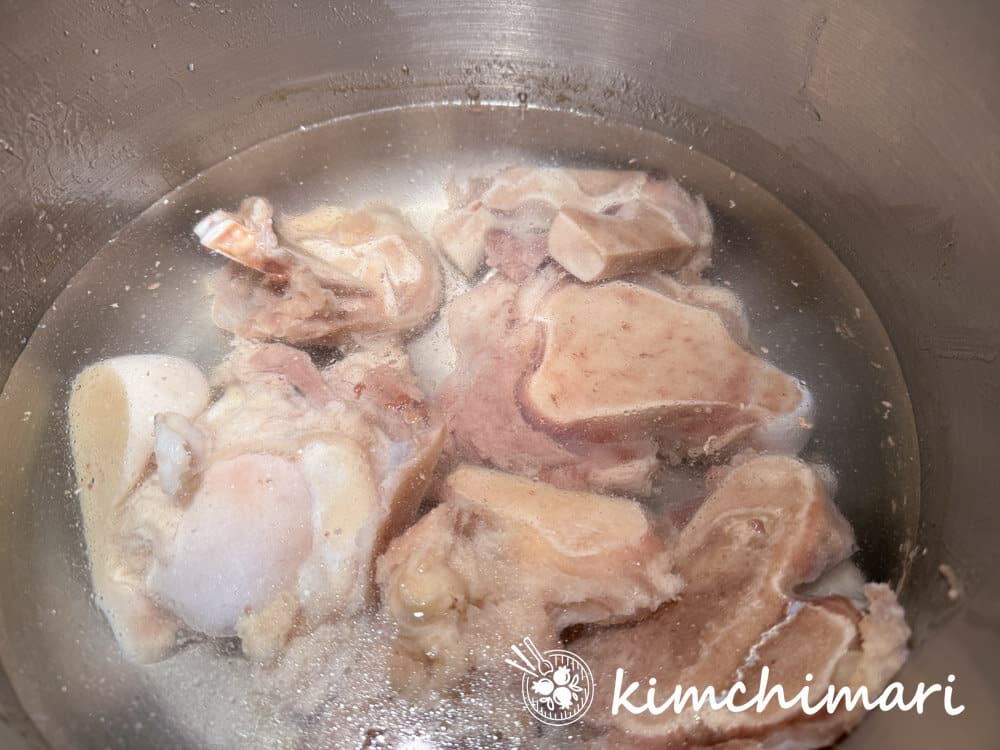
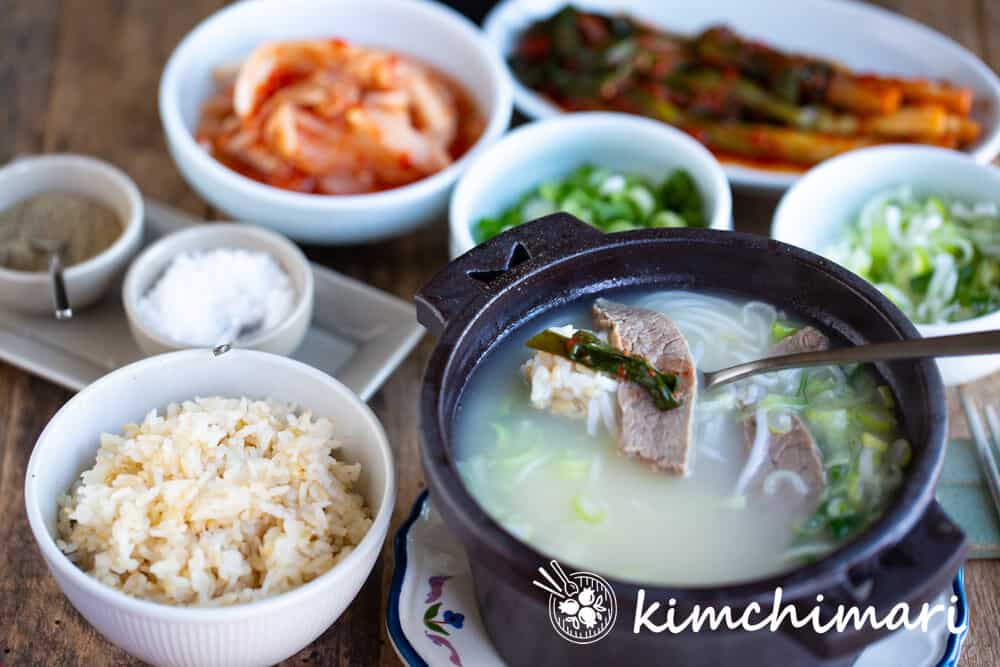






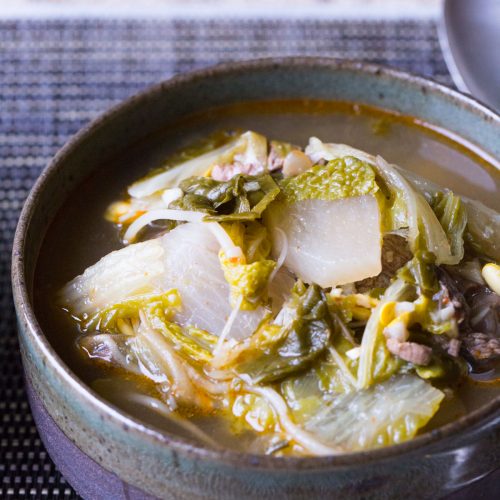
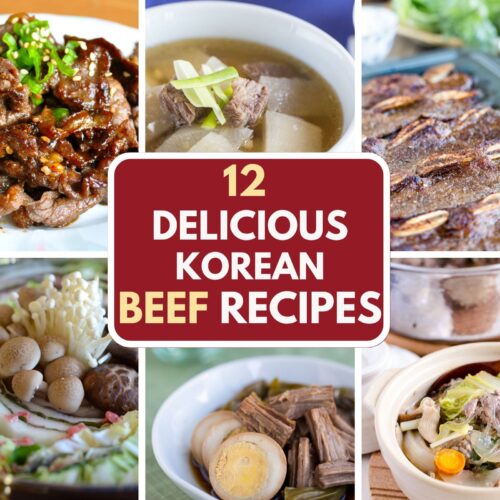
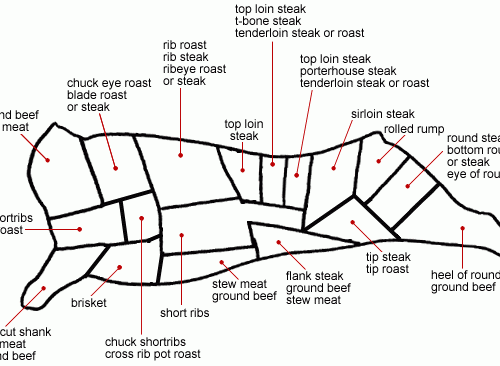
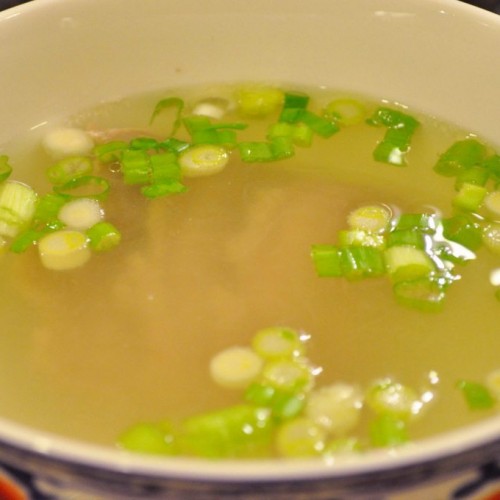
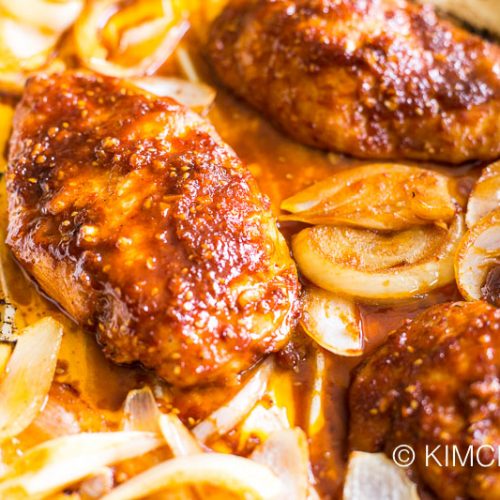
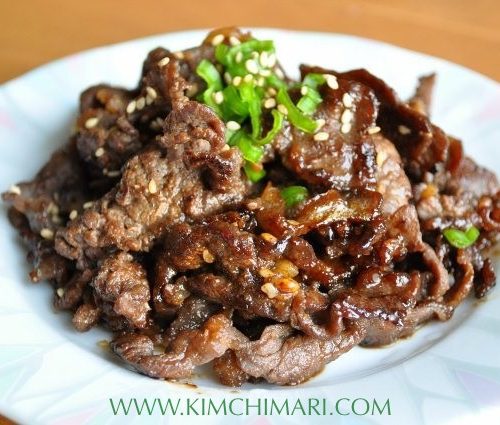
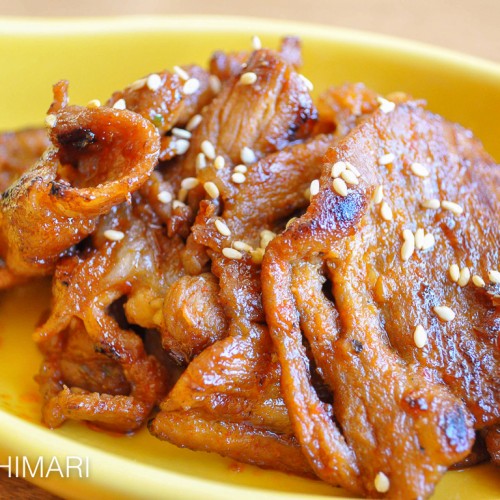
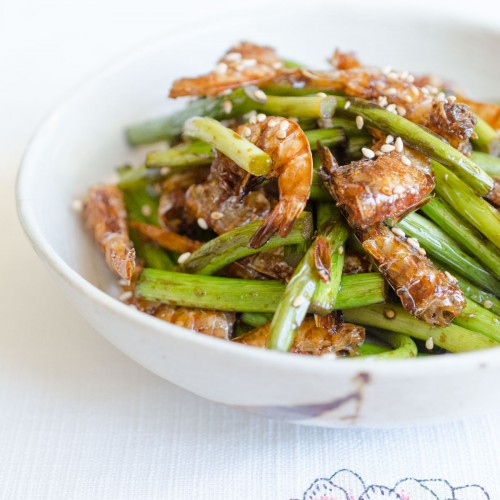
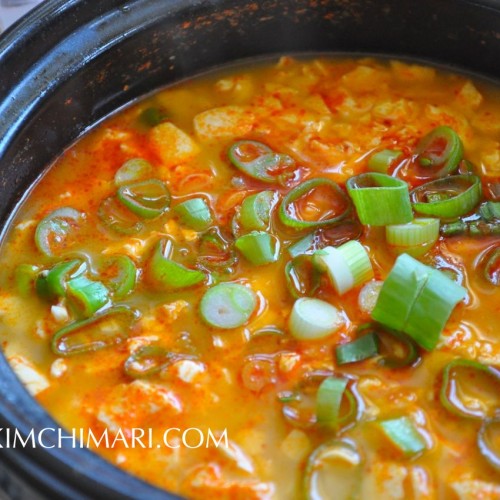
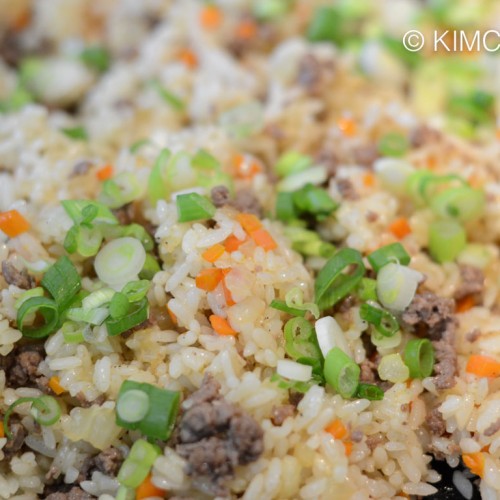
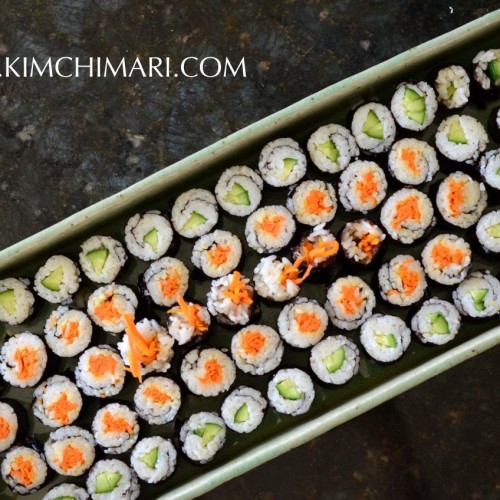
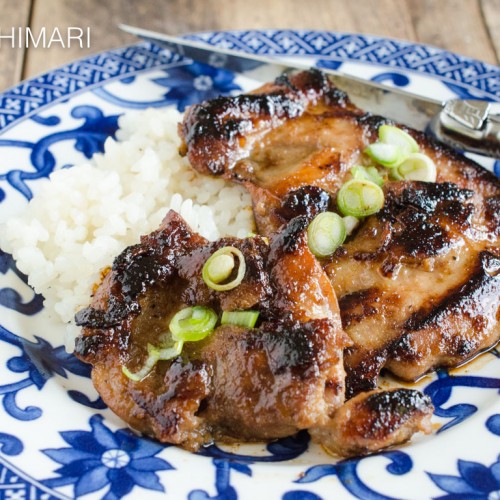
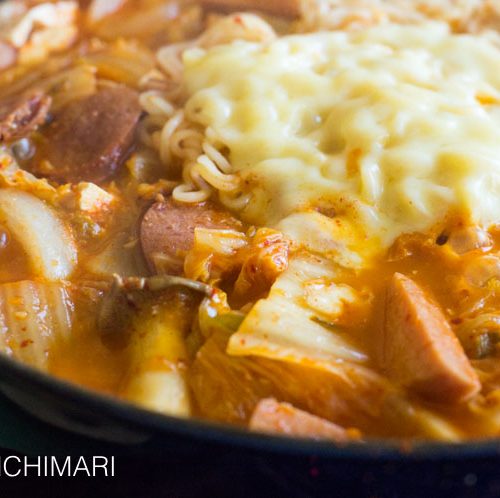
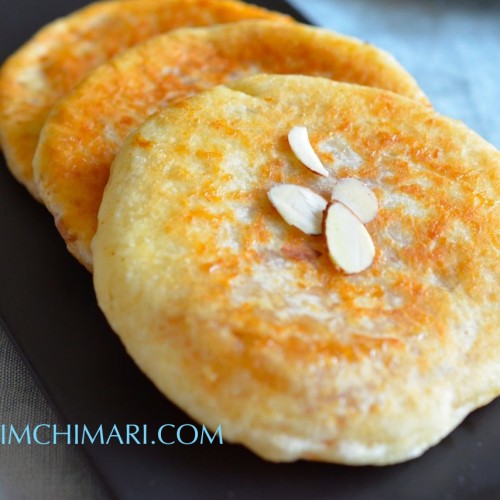






Thank you so much Jinjoo! My broth is milky from your detailed recipe, I’m definitely going to make this again!
Lovely to hear that!! Glad the beef bone broth turned out milky wonderful for you. Enjoy!
Hi JinJoo! I tried other recipes for Seollongtang but yours seems the most precise I found so far! I will definitely try it next time I make it. Thank you for sharing it (and cooking it multiple times, that is a HUGE load of work! @_@)
That’s excellent to hear!! Thank you soo much for your kind words – I did try my best to make it as precise and to simplify the process as possible. Love to hear how it worked out!